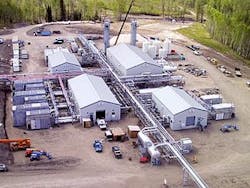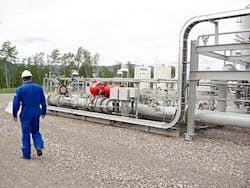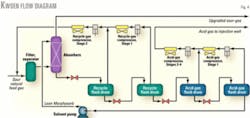KWOEN GAS PLANT—1
Duke Energy Gas Transmission Corp. (DEGT) started up the first commercial application of the Morphysorb process at its Kwoen plant (Fig. 1) near Chetwynd, BC, in August 2002. The unit has operated successfully without any solvent-related problems and the plant had processed about 135 bcf of sour gas as of May 2004.
The solvent showed a higher relative absorption of acid-gas compounds compared to competing solvents, which lowered circulation rates. The solvent also had lower relative absorption of heavier hydrocarbons, which also further reduced circulation rates, lowered recycle-gas compression costs, and increased heating value and decreased losses in the sales gas.
This first of two articles presents background information on Morphysorb process development and discusses the first commercial project opportunity.
Part 2, next week, will discuss Morphysorb process performance and operational issues associated with solvent performance since plant start-up in August 2002. Part 2 will also highlight the technical advantages of Morphysorb compared with other commercial physical solvent processes.
Background
Natural gas at the wellhead often contains unacceptably high levels of acid gases, such as hydrogen sulfide and carbon dioxide, that degrade the heating value and create operating problems for pipeline companies.
About half of all natural gas produced in the US requires processing to remove CO2, H2S, and nitrogen. Cost-effective removal of these undesirable gases makes more gas available to consumers at an affordable price.
The Gas Technology Institute (GTI) has researched gas-processing technology since the mid-1970s and has identified the morpholine chemical family as promising candidates for acid-gas removal. GTI has worked with Uhde GMBH in these extensive research efforts.
Since 1968, Uhde has successfully used such morpholine derivatives as N-formylmorpholine (NFM) to recover high-purity aromatics and separate butane and butene. This research has resulted in such commercial processes as Morphylane, Morphylex, Octenar, and Butenex.
Morphysorb technology uses mixtures of NFM and N-acetylmorpholine as solvents to remove CO2 and H2S from subquality gas. These general properties characterize the Morphysorb process:
The Gas Research Institute in 1990 used an earlier work that identified NFM as a leading candidate for acid-gas removal for coal-gasification processes as the basis to explore NFM's application in upgrading subquality natural gas.1
More than 200 vapor-liquid equilibrium experiments were conducted with the gas phase containing pure components and mixtures with CO2, H2S, methane, ethane, and carbonyl sulfide. The vapor-liquid equilibrium data formed the basis for intensive regression analysis using process-simulation software for further use in thermodynamic modeling.
Field tests with a pilot plant capable of processing up to 1 MMscfd of gas at approximately 1,000 psig later validated the simulation data.2-4
GTI constructed this process development unit as a skid-mounted gas processing pilot plant for field testing at gas wellhead sites to evaluate the improved solvent technologies. Physical and chemical solvents can be tested in this facility,2-4 which has an 8-in. diameter absorption column and an 18-in. diameter regenerator, with either structured or random packing, at feed gas rates up to 1 MMscfd.
More than 100 tests were performed with the morpholine family of solvents, processing a total of 50 MMscf of sour gas with acid-gas concentrations up to 45%.
Based on field-test experimental data, GTI-Uhde developed a computer simulation model to verify the benefits of the Morphysorb process. The solvent has a high relative absorption of acid-gas compounds compared to competing solvents, which results in lower circulation rates. It also has lower relative absorption of higher hydrocarbons, which results in fewer losses and more heating value in the sales gas.
Simulation results indicate that the new solvent system will outperform the commercial physical solvent applications for gas-sweetening processes.5-7
The Morphysorb process can also remove such organic sulfur compounds as COS, CS2, and mercaptans. Because of its hydrophilic characteristic, the solvent can also dehydrate simultaneously. Conversely, no additional dehydration step is required downstream from a Morphysorb unit if the feed gas is already dehydrated.
First commercial application
DEGT is a gas gathering and processing service provider to oil and gas producers in northeast BC and operates a sour natural gas gathering system in the Pine River area.8 9
The original system consisted of a 260-MMscfd gas plant and an 83-mile gas gathering trunk line and laterals (Fig. 2) where the gas is desulfurized, dehydrated, and sulfur is recovered.
The plant can remove 50 MMscfd of acid gas (H2S and CO2) and produce 1,050 long tons/day of elemental sulfur at a recovery rate of 99%. The plant sulfur capacity was nearly doubled to 2,000 long tons/day after an expansion in 1994.
Since the start-up of the 1994 Pine River expansion, the acid-gas quantity has increased to 21% from the original design of 16.8%, which was the expansion's design basis composition. The plant was at full capacity due to the maximum amount of total acid gas and H2S that fed the plant; however, from a raw-gas flow perspective, the raw feed was 120 MMscfd less than the plant design.
To process an additional 120 MMscfd of sour gas, DEGT could have either added more gas treating and sulfur-conversion capacity at Pine River or installed processing capacity upstream in the Pine River gathering system that would remove acid gas prior to reaching the Pine River plant.
Due to a significant cost advantage, DEGT decided to pursue the latter option. By 2000, however, new sour gas in excess of 130 MMscfd needed transportation and processing. The new sour-gas wells were as far as 69 miles from the current Pine River gathering area.
To gain access to the gas-production areas, DEGT needed the new processing capacity, sour-gas compression, and a sour-gas pipeline. A new Pine River expansion project was therefore commissioned.
The new Kwoen upgrader gas plant was designed to use all the remaining hydraulic throughput, sour-gas removal, and sulfur recovery of the Pine River plant.
The processing plant contains a bulk acid-gas removal unit and an acid gas reinjection facility. The plant does not produce a sales-gas-specification product; it simply upgrades the feed gas to allow the maximum sour-gas flow through the Pine River plant (Fig. 3).9 10
Morphysorb process selection
Although the Kwoen plant was originally designed and constructed for a different conventional physical solvent process, DEGT decided to switch to the new Morphysorb solvent at a final project stage due to the prospect of increased plant capacity with lower operating costs and no necessary plant modifications.
Compared with the original acid-gas removal process, the Morphysorb process predicted lower hydrocarbon losses in the acid-gas stream, more capacity for acid-gas removal, and lower pumping and recycle horsepower requirements.
GTI and Uhde, the process licensor, jointly investigated the solvent change and entered into a demonstration agreement with DEGT.
As a part of agreement, GTI-Uhde conducted an engineering review before the solvent was purchased and loaded into the system. GTI-Uhde provided DEGT with the review and recommendations regarding the suitability of the "as-built facility" for use with the Morphysorb process.
The engineering review included a:
The engineering review of the DEGT Kwoen plant by GTI-Uhde resulted in these minor recommendations:
After minor changes to the original design, mainly related to the sealing material, the Morphysorb solvent (manufactured by BASF AG) was installed in the plant and initial testing started.
Kwoen plant design
The Kwoen gas plant is a bulk-removal facility with a simple flash-regeneration design (Fig. 4). A total of 300 MMscfd of sour gas to the Pine River gas plant is directed to the Kwoen plant, which operates at 1,100 psia.
The gas is absorbed by Morphysorb solution in two parallel 150 MMscfd packed-column absorbers. The lean Morphysorb flow to each absorber is as high as 1,500 gpm.
Enriched solvent exits the bottom of the absorbers and is consecutively flashed into the two recycle-gas flash drums at 425 psia and 185 psia. Offgas from these flash drums is recycled back to the absorber feed via a two-stage reciprocating compressor to minimize methane losses.1-3
The solvent is further flashed into the two acid-gas flash drums for regeneration. The drums operate at 65 psia and 25 psia, respectively.
Acid gas is produced at two pressure levels to minimize compression energy required for high-pressure downhole reinjection. The regenerated Morphysorb solvent is pumped back to the absorber via the booster and high-pressure charge pumps.
The solvent-circulation system also contains a mechanical and carbon-filtration system, which processes about 10% of the total Morphysorb circulation volume.
The simple flash regeneration and autorefrigeration of the Morphysorb solvent eliminate the need for some standard pieces of equipment, such as a regeneration column, reboiler, process-heat medium system, overhead condenser, reflux drum, reflux pumps, solvent-solvent heat exchangers, and solvent coolers.
The acid gas removed from the sour natural gas is not converted to elemental sulfur in a sulfur-recovery unit as in other conventional sour-gas plants.
After compression in a four stage acid-gas compressor, the acid gas is liquefied and fed to the 9 mile, 6-in. OD acid-gas pipeline at 1,100 psia (Fig. 5). Liquefied acid gas arrives at the injection well as a liquid and flows down the well tubing to a depth of more than 8,200 ft.
Table 1 summarizes the design operating stream conditions and compositions.
Producers served by the Pine River system must dehydrate the gas before it enters the gas gathering receipt points. Molecular sieve adsorption dries the gas to a water content of 4 lb/MMscf.
Due to the low water content in the solvent (<1 wt %), acid gas remains dehydrated. Even an unexpected high-pressure loss across the reinjection control valve that resulted in a temperature drop of more than 30 K. did not lead to any injection-well problems due to hydrates.
The NGL content is only 200 ppm (vol), which approximates the sales-gas dewpoint specification. Hydrocarbon liquid recovery facilities are therefore not required at Pine River.
The plant feed contains a significant amount of trace sulfur compounds. The carbonyl sulfide and mercaptan content both exceed 300 ppm (vol); the Morphysorb solvent removes 30% of this.
References
1.Semrau, J.T., Palla, N., and Lee, A.L., "Subquality Natural Gas Sweetening and Dehydration Potential of the Physical Solvent N-Formyl Morpholine," presented at the 45th Annual Laurance Reid Gas Conditioning Conference, Norman, Okla., Feb. 26-Mar. 1, 1995,.
2.Palla, N., Lee, A.L., Leppin, D., Shoemaker, H.D., Hooper, H.M., and Moore, T.F., "An Acid-Gas Removal System for Upgrading Subquality Natural Gas," presented at the XII Jornados De Gas, Puerto La Cruz, Venezuela, May 8-11, 1996.
3.Gross, M., and Menzel, J., "Acid Gas Removal for Upgrading Natural and Synthesis Gas, Part One," Hydrocarbon Engineering, November 1997.
4.Palla, N., and Lee, A., "Field Test Results of the Physical Solvent N-Formyl Morpholine for Gas Treating" presented at the US.Department of Energy's Natural Gas Conference, Houston, Mar. 24-27, 1997.
5.Palla, N., Lee, A.L., Gross, M., Hooper, H.M., Menzel, J., and Leppin, D., "Advancements in Treating Subquality Natural Gas Using N-Formyl Morpholine," presented at 77th GPA Annual Meeting, Dallas, Mar. 16-18, 1998.
6.Palla, N., Lee, A., Gross, M., Hooper, H.M., Menzel, J., Tondorf, O., and Leppin, D., "A New Gas Treating Process for Upgrading Subquality Natural Gas using N-Formyl Morpholine," presented at the International Gas Research Conference, San Diego, Nov. 8-11, 1998.
7.Gross, M., Menzel, J., and Tonforf, O., "Acid Gas Removal for Upgrading Natural and Synthesis Gas, Part Two," Hydrocarbon Engineering, June 1998.
8.Kowalsky, G., Leppin, D., Palla, R., and Jamal, A., "Large Scale Demonstration of Morphysorb Technology on Natural Gas Treating," presented at the GTI Natural Gas Technologies Conference, Orlando, Sept. 30-Oct. 2, 2002.
9.Kowalsky, G., Leppin, D., Palla, N., Jamal, A., and Hooper, M., "Performance of Morphysorb in a Commercial Acid Gas Treating Plant," presented at the 53rd Laurance Reid Gas Conditioning Conference, Norman, Okla., Feb. 23-26, 2003
10.von Morstein, O., Menzel, J., Palla, N., and Leppin, D., "An Ace at Removal," Hydrocarbon Engineering, February 2004.
The authors
Nagaraju (Raj) Palla is manager of gas processing research at the Gas Technology Institute (GTI), Des Plaines, Ill. He has been extensively involved in the development of Morphysorb technology, from inception through commercialization. During the last 10 years at GTI, Palla has participated in and directed research projects on subquality gas upgrading, treating, dehydration, aromatics removal, and H2S scavenging. He holds an MS in mechanical engineering from Illinois Institute of Technology. He is a member of ASME.
Aqil Jamal is a principal chemical engineer specializing in acid gas treating, sulfur recovery, and process simulation at GTI's Gasification and Gas Processing Center, Des Plaines, Ill. He has also served as assistant professor at the University of Regina, Sask. Jamal holds a PhD in chemical engineering from the University of British Columbia, Vancouver. He is a member of AIChE.
Dennis Leppin is associate director of GTI's Gasification and Gas Processing Center, where he directs gas processing research and development, a position he has held since 2000. Previously he was principal project manager for the Gas Research Institute and held positions with the Institute of Gas Technology in coal gasification research. Leppin holds a BE and an ME, both in chemical engineering, from City University of New York, the City College, and an MBA from the University of Chicago. He is a registered professional engineer in Illinois.
Johannes Menzel is senior process engineer for gas treating at the Gas Technology Division of Uhde GMBH, Dortmund, Germany, a position he has held since 1997. He has been an active participant in the development of the Morphysorb Process at Uhde. From 1985 to 1996, Menzel held engineering positions with Krupp Koppers GMBH, Essen. His areas of interest include gas treating and sulfur recovery plants for synthesis gas from gasification plants. Menzel holds a masters in chemical engineering from the University of Dortmund, and holds several patents.
Olaf von Morstein heads the gas-treating group in the Gas Technology Division of Uhde GMBH. Previously he was senior process engineer for gas treating in the same division for Uhde and worked as a research engineer at Krupp Koppers GMBH, Essen. His professional interests include gas treating technologies for synthesis gas from gasification plants, acid gas removal, sulfur recovery, and process simulation. He holds a masters in chemical engineering and a doctorate from the Technical University of Magdeburg, Germany. He is a member of VDI (Association of German Engineers).
H. Maxwell (Max) Hooper is vice-president, business development, gas technologies, for Uhde Corp. of America, Sewickley, Pa. He joined Uhde in 1992 and his responsibilities include the development of technical and commercial proposals for the gas, refining, and petrochemical industries. Hooper has 35 years' experience in process engineering, design, and operation of gas treating facilities, refinery and petrochemical systems, coal gasification systems, and coal chemical plants. He holds a BS in chemical engineering from West Virginia University, and an MBA from Duquesne University, Pittsburgh.






